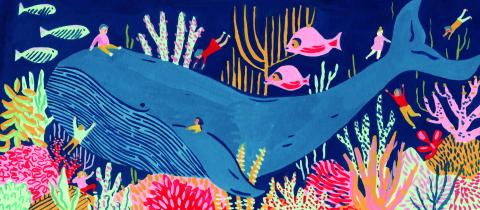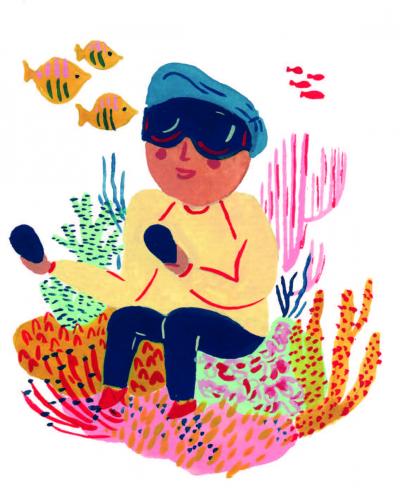Virtual Learning for Special Needs Students

Story by Mary Ellen Alu & Artwork by Josefina Schargorodsky
First, the elementary school student surveyed his surroundings—the expanse of the deep sea, the rich blue hue of the water, the wreckage of a ship. Above him, sunlight streamed through the water. Stingrays swam.
Look around, a teacher prodded; a visitor will be coming.
“All of a sudden,” said the young student excitedly, recounting the experience, “a big whale just [came] in and [stopped] there, [looked] at me. I just looked into his eyes. All the fish swam away. When he left, it felt like he was going to slap me with his flipper and hit me with his tail until he almost hit the ship….”
Though excited about the adventure, the student didn’t have to venture far beyond his classroom at Centennial School in Bethlehem, Pa., to explore the deep wonders of the sea. He took a virtual dive at Lehigh’s College of Education with fellow elementary school students as part of a study into whether virtual reality experiences can enhance the writing fluency of students with special needs. Centennial School, governed by the College of Education, serves children with autism and behavioral challenges.
“It felt like I was really underwater,” the student recalled to researchers after being immersed in the Blu Whale Encounter. “Every time the fish came near me I would duck down because I thought maybe they were really going to hit me. It felt really real.”
Scott Garrigan, professor of practice emeritus of Teaching, Learning and Technology at Lehigh, led the study, which exposed students to an HTC Vive virtual reality system and assessed whether the experience under the sea transformed the students’ writing and storytelling. Was their writing more sophisticated? Did they provide more detail, a voice, a focus? Did they have more to say?
Co-principal investigators were Julie B. Fogt, director of Centennial School, and Sara Heintzelman, the school’s technology integration specialist. Also participating were graduate student Sarah Burton and Centennial School computing consultant Ed Bruno.
From the start, researchers were optimistic that the experience would improve student learning. Prior to the study, two Centennial students who had tried out the Vive system had loved the experience, and one of them—a student who usually had trouble expressing himself—had been so engaged that he wrote a rich, detailed description of what he saw.
“This is powerful stuff,” Garrigan said at that time, then asked, “Does that work with every kid?”
The study, conducted in spring 2017, hoped to begin to answer that question. The researchers exposed 13 third-, fourth- and fifth-graders to two different experiences—seven students were part of a treatment group that visited the deep sea in virtual reality; six were in a delayed treatment, or control, group that watched a video of similar length made from screen grabs of the virtual-reality whale encounter on an iPad.
To balance the groups, researchers first issued and analyzed standard writing prompts. “We wanted to ensure that the treatment group and the wait list control group were equal in terms of their writing abilities to properly evaluate the effects of the VR exposure,” Fogt said.
The students in the treatment group visited COE’s virtual reality lab, where they donned the Vive headsets and goggles that allowed them to look around—and move around in—the virtual space. The encounter with the huge blue whale took them by surprise—and, ultimately, got them writing. Researchers also recorded students’ comments while they were immersed in virtual reality, and afterward, talked to them about the experience.
Initial findings showed that students in the treatment group were able to write more about what they saw than those in the control group. “It’s a way they can connect with writing that perhaps some of the kids haven’t ever experienced before,” Fogt said. “From our group of participants, I don’t know of any who have gotten to go scuba diving or snorkeling, or have that experience. So it’s another way for them to connect with information on a deeper level.”
Fogt and Heintzelman analyzed writing sequence, word counts, spelling and punctuation.
“There are few studies conducted on the effectiveness of integrating technology to meet the needs of students with behavioral disorders,” said Heintzelman. “This study is one step in moving the fields of special education and educational technology toward recognizing the potential impact of VR on students with special needs.”
 The research team hopes to replicate the study conducted with elementary school students with middle school and high school students as early as spring 2018.
The research team hopes to replicate the study conducted with elementary school students with middle school and high school students as early as spring 2018.
“We are highly interested in studying the impact of technology integration on academic outcomes for students identified as having emotional and behavioral disorders because we know that students with EBD tend to not receive the same kinds of experiences as their counterparts in regular education,” Fogt said. “For example, some students with EBD are excluded from field trips, even educational ones, due to concerns about their behavior and the school's ability to ensure student safety... So it's really important to us that students with challenging behaviors access a rich school experience.
“Some people would caution us against placing very expensive technology in the hands of students with co-morbid impulsivity and anger issues, saying, ‘Are you afraid that they are going to break it?’ And it's that kind of thinking that then precludes students with EBD from accessing technology,” Fogt said. “In fact, we've found just the opposite. Every time we've given technology to students with behavior problems, they've used it respectfully and as directed. That's a really important discernment. With clear expectations and proper support, we can structure the experience so that students can benefit from interacting with technology.”
If the students felt uncomfortable at any time with the virtual reality experience, they were able to withdraw their participation.
“It’s important they know they have a choice in what they do,” Fogt said.
The research team hopes to submit the manuscript for review in November 2017.
In addition to the study, Garrigan trained students, faculty and community leaders in the use of the Vive system and tested its capabilities. At the COE lab, participants can also step inside a museum, where they can get a close-up look at Leonardo da Vinci’s Mona Lisa or stand beside Terracotta Warriors from China. They can create colorful art all around themselves.
Students in Garrigan’s advanced multimedia development class also built experiences to explore ways that full, immersive virtual reality can be used in education.
“Virtual reality is a very powerful educational system,” Garrigan said. “Just as we learn very rapidly through hands-on activities or watching someone do something in real life, those things can be modeled in VR in ways that are more powerful than reading about it or watching a film. It can be interactive.”
Garrigan is excited about the possibilities that virtual reality can create in the classroom.
“This is Thomas Edison’s flickering screen,” he said, making reference to inventions by Edison and his team in the area of motion pictures. “It’s just beginning, but it’s still powerful even in its beginning.”